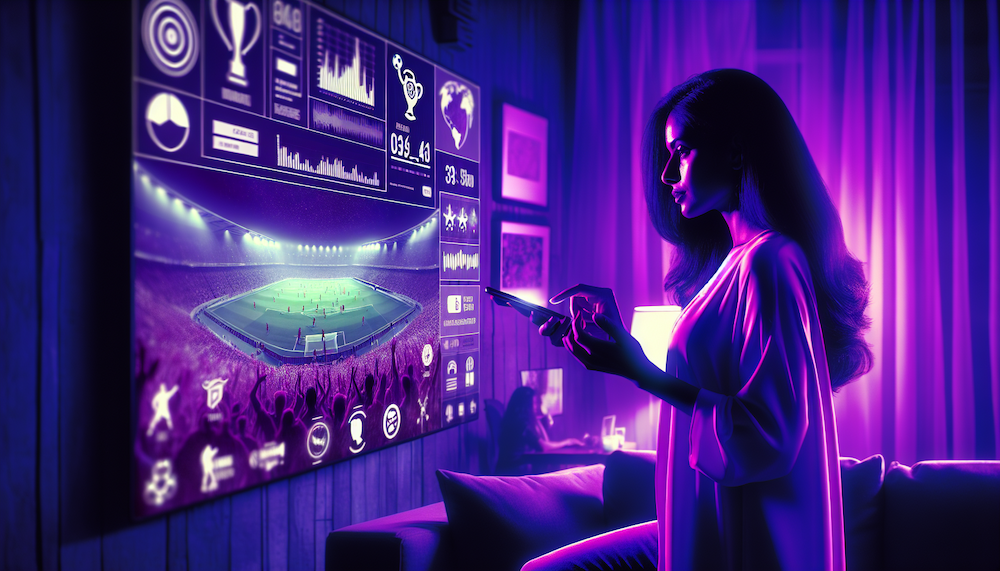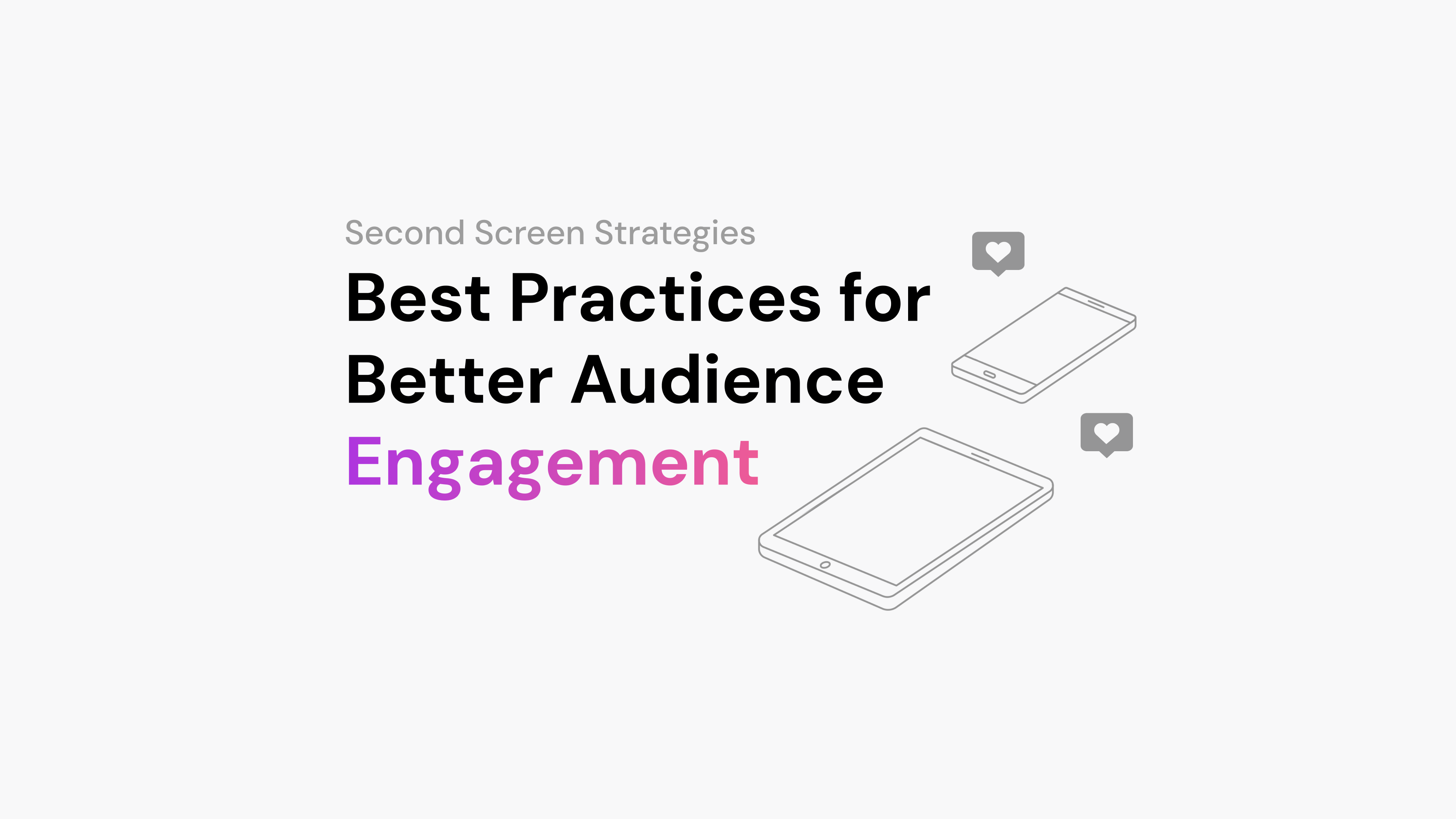The rise of the ‘Second Screen in Sports’ is changing how fans engage, offering new ways for sports professionals to connect with audiences and grow. By using interactive technologies during live events, you can turn viewers into active participants, improving the fan experience and opening new revenue opportunities.
What is Second Screen in Sports?
Second screen in sports refers to sports fans, spectators and supporters using an extra device, like a smartphone or tablet, to access interactive content and engage with the game in real time while watching a live sports event on television.
Engaging Fans Through Second Screens
Using a second screen allows fans to participate more during sports events. By adopting effective second screen strategies, they can access live statistics, watch instant replays, and join discussions on social media platforms. About 45% of U.S. sports fans use a second screen while watching games on TV, increasing their enjoyment by sharing opinions and accessing additional information (Oxagile).
Enhancing Sports Events with Second Screen Experiences
Second screens make viewing more interactive. Fans can take part in polls, quizzes, and prediction games related to the live action. Sports organizations offer apps and platforms with extra content, such as behind-the-scenes footage and exclusive interviews. Providing this content helps build a stronger sense of community.
3 Main Types of Second Screen Experiences in Sports
Second screen experiences offer various ways for fans to engage with sports events, including interactive features, social media integration, and access to additional content.
Interactive Features and Real-Time Engagement
Fans can interact with live sports events in real time through their second screens, making viewing more engaging. They can participate in polls, access live statistics, or join prediction games. Teams and leagues are developing apps and digital platforms that allow fans to:
- Access real-time stats, replays, and alternative camera angles
- Participate in quizzes and prediction games
- Chat with other fans and share reactions
Offering these features helps to engage sports fans and provides additional touchpoints for team and sponsor activations.
Social Media Integration
Many fans use social media platforms like Twitter and Facebook during games to share their thoughts and reactions. Twitter sees a 4% increase in visitors during live sports events, and sports team pages on Facebook have significant reach. Social media integration fosters community among fans and provides teams with valuable insights into fan sentiment. Fans use second screens to:
- Connect with friends and family, sharing the excitement of big moments
- Be the first to share content, stats, or memes
- Participate in discussions using team hashtags
Stats and Highlights
Second screens allow fans to access additional information that enhances their understanding and enjoyment of the game. Viewers use their devices to look up player stats, game highlights, and commentary. During the 2014 UEFA Champions League match, 63% of searches for games, players, and teams occurred on mobile devices. Fans can:
- Watch instant replays and highlights
- Access real-time statistics and player information
- View behind-the-scenes content
These features provide fans with a more immersive experience and keep them engaged throughout the game.
How to Implement Second Screen Strategy in Sports
Here’s how you can implement effective second screen strategies in sports events, shaping the future of sports broadcasting.
- Creating a seamless second screen experience starts with aligning your digital platforms with the live event. Developing companion apps that synchronize with the broadcast allows fans to access real-time stats, replays, and alternative camera angles. Offering interactive features like polls, quizzes, and prediction games keeps fans engaged throughout the event.
- Providing unique, high-value content is essential. This might include exclusive behind-the-scenes footage, athlete interviews, or augmented reality features that fans can’t find elsewhere. Ensuring your app is intuitive and user-friendly, especially during critical moments of the game, enhances the overall experience.
- Social media integration is another key component. Facilitating real-time discussions and easy sharing of content allows fans to connect with each other and amplify the excitement of the event. Connecting personal devices with in-stadium displays can also create a unified experience for both at-home and in-person audiences.
- Proper synchronization between screens is crucial. Seamless integration across platforms prevents lag and distraction, keeping fans immersed in the action. By focusing on these elements, you can create a second screen experience that complements the live event and deepens fan engagement.
How Does Second Screen Integration Work in Sports Events?
Second screen integration connects fans’ devices with live sports events, synchronizing content across multiple screens and allowing fans to engage with games in real time.
Real-time data synchronization is essential for second screen experiences. It ensures that the information on the second screen matches the live action without delay. As the game progresses, fans can access live stats, instant replays, and interactive features on their devices. Second screen apps sync with live data feeds to provide up-to-date player statistics and game analytics, catering to a real-time audience. By synchronizing content in real time, fans receive timely updates that enrich their viewing experience.
Monetization Opportunities with Second Screens
Second screen experiences in sports offer new ways to generate revenue and monetize sports communities, creating additional touchpoints for monetization that complement the main broadcast.
Advertising and Sponsorship Potential
With nearly half of viewers using multiple screens during big games, there’s a significant opportunity for targeted advertising. According to a Nielsen report, 45% of adults often use a second device while watching TV, and 69% use it to learn more after seeing an ad. This behavior allows for personalized ads based on real-time events and user interests, providing opportunities for monetizing sports content.
You can collaborate with sponsors and sports influencers to create exclusive second screen content, such as behind-the-scenes footage, interactive stats, or special interviews sponsored by brands, enhancing the fan experience while promoting partners. Integrating e-commerce directly into the second screen also enables fans to purchase merchandise or tickets seamlessly during the game.
Gamification Elements to Drive Revenue
Incorporating gamification into second screen apps encourages fan participation and helps you monetize a sports community by opening additional revenue streams. Prediction games, trivia, and fantasy sports elements keep fans engaged and can be monetized through in-app purchases or premium features.
For example, apps like WinView have partnered with brands to offer live prediction games during events, creating sponsorship opportunities and boosting fan interaction. By introducing virtual rewards or leaderboards, you can encourage fans to spend more time on your platform, increasing exposure to ads and potential microtransactions.
Benefits of Second Screen in Sports
Second screen experiences are changing how fans engage with sports events, offering new ways to connect with fellow fans and creating opportunities for revenue growth.
Second screens create vibrant communities by allowing fans to interact in real time during games. By leveraging community tools, they can share reactions, participate in discussions, and feel more connected to the action through platforms that offer group chat features, discussion forums, and social media integration that bring fans together. According to Stats Perform, these interactive elements turn passive viewers into active participants, enhancing the overall experience and helping to build online communities and scale a sports community.
Second screens also enable personalized content, where fans receive recommendations based on interests, strengthening loyalty and connection with other fans.
Don’t Forget to Measure Your Fan Engagement
To assess the effectiveness of your second screen strategies, it’s important to establish clear goals and metrics. Monitoring real-time analytics within your app provides insights into user behavior, such as time spent, features accessed, and content viewed. Utilizing real-time sales alerts can help you respond promptly to user actions and never miss an opportunity. Gathering user feedback through surveys and reviews offers valuable information on what’s working and areas for improvement.
Analyzing social media interactions can also help measure engagement. Tracking mentions, shares, and likes related to your second screen content reveals how fans are interacting with your offerings. Evaluating monetization outcomes, like revenue from in-app purchases, advertising, and sponsorships, assesses the financial success of your initiatives.
Consider the return on investment by attributing value to your second screen efforts in relation to costs. Using these insights, you can continually refine your strategies to enhance the fan experience and achieve your objectives.
By embracing second screen technology, you can change how fans engage, turning viewers into active participants and opening new revenue opportunities. Implementing these strategies not only enhances the fan experience but also strengthens your digital presence, driving growth and achieving your business goals.
Ready to see the impact of an effective sports community on your bottom line? Sign up now at Arena and start leveraging our powerful features to boost engagement and retention. Join thousands of brands that trust Arena to turn visitors into loyal customers.



